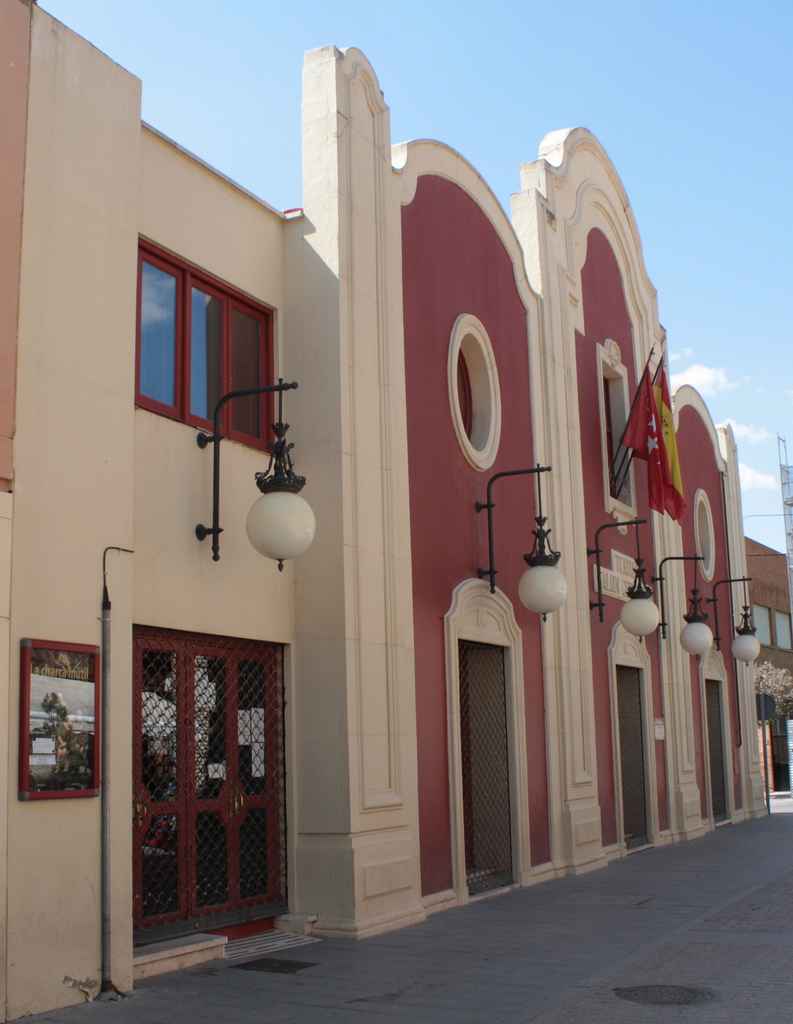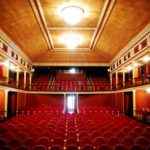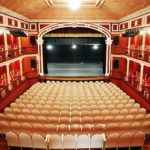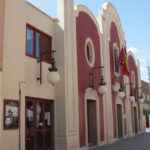Este texto también está disponible en español
Teatro Salón Cervantes is the most important theatre of Alcalá, without leaving aside Corral de Comedias. Discover why it is named after Cervantes and why this is such important.
The only showroom and theatre of Alcalá has been, during long time, Teatro Salón Cervantes. It is placed in the middle of city center, in streets with the writer’s family name and next to calle Mayor. Premises of the building had been allocated as theatre, ballroom, cinema and bingo hall. After the huge refurbishment of 1989, it was turned again into a wonderful nineteenth-century theatre in which dramas and operas are continuously offered. Honoring such old times, nowadays the theatre is headquarter of Festival de Cine de Cortometrajes in November.
Luckily, today Alcalá has two official theatres property of the Community of Madrid, as Corral de Comedias and Teatro Salón Cervantes, besides others such as La Galera—run by the university—and the auditorium Margarita Xirgú—owned by the labor union Workers Commissions—, as well as several other places that occasionally holdperformances.
The Supposed Cervantes Birthplace
In the middle of twentieth century, there was a belief in Alcalá—without none historical base but anyway very extended among population—, Miguel de Cervantes Birthplace was partially into the vegetables garden of Capuchinos Convent —today’s holding a restaurant— at the corner between calle Santiago and the current calle Cervantes, which was then named calle de la Tahona. The convent and its vegetable garden were bought by an individual after the Ecclesiastical Confiscations of Mendizábal .
In 1846, its owner asked to place a plaster cast bust of Miguel de Cervantes and two tombstones commemorating such place. After that, the City Council decided to change the street name from calle de la Tahona to calle Cervantes, current in our times.
The City Council considered buying the piece of land—including the vegetable garden—to build up a theatre or museum dedicated to the writer, but there were not funds. In the meanwhile it was purchased in 1886 by different owners who desired to raise a building for their own economic interests, so the bust and tombstones were returned to the City Council.
Build up in 29 Days
However, a great polemic arises in the city facing what it was considered as an affront to Cervantes memory. Thus, the City Council bought most part of the vegetable garden while a group of neighbors made up the “Compañía constructora del Salón Cervantes”, which took care of the building and the theatre allocation previously planned. In order to carrying it out, they issue shares valuable in 100,000 pesetas—equivalent to 600 € or $830, from nineteenth century.
Teatro Salón Cervantes was constructed in only 29 days, an authentic hit of quickness referring to architecture. Its façade is modernist style, with very simple lines, made by bricks. It was inaugurated in spring of 1888.
The belief that Teatro Salón Cervantes was built up upon the emplacement of Cervantes family house still present in 1905, when the third centenary of Don Quixote was celebrated. After that moment, a new plate was placed—the previous had disappeared—remembering the “illustrious son of Alcalá”. However, we should notice that it was not until 1953 when the specialist in Cervantes Luis Astrana Marín discovered the proofs by which Cervantes house was placed in the area it is set today.
Ballroom, Bingo, Cinema and Theatre
The building, as it was testified by some old photos, was in a poor condition in 1920. This leaded to the execution of an important refurbishment in 1925, and that was when the red-brick façades were painted on red and the door and window moldings turned white, as we know them today. Its capacity was also enlarged and the second floor changed its old wooden boxes for brick ones.
A curiosity is that during postwar, when the powder keg of El Zulema in 1947 broke out, Teatro Salón Cervantes was allocated to help wounded people, as it counted on an electric generator, the only of Alcalá, apart from that of the City Council.
In that period, after the Civil War, was when the theatre was turned into a cinema. The building, that in 1973 was also a ballroom, was abandoned once again. Therefore, it was sold and turned into a bingo hall in 1979, until it was bought again by the City Council in 1986.
Three years later, in 1989, the Community of Madrid renovated it completely so it could become again a nineteenth-century theatre, with its orchestra, boxes and scenery. That is the reason why today it is included into the red de Teatros de la Comunidad de Madrid [Community of Madrid Theatre Network].
Since then, it develops a continuous activity with regular seasons of theatre and performing arts such as dancing, opera concerts and musicals, as well as being the headquarter of Festival de Cine de Cortometrajes, ALCINE, Alcalá’s Short-Film Festival, every November, and Classics of Alcalá, in June.
Likewise, this is the place in which the City Council awards their institutional prizes and official acts are celebrated. And every week here, you might see the programming of Alcalá’s Cinema Club . And when the weather is good, in more than one chance you can attend to concerts and outdoor spectacles in the enclosed garden next to the theatre, owned by the same Teatro Salón Cervantes.
Additional information:
- cvc.cervantes.es
- www.jccanalda.es
- www.redescena.net
- enciclopedia.us.es
- porlascallesdealcala.blogspot.com.es
Useful information:
- Calle Cervantes, s/n
- 28801 Alcalá de Henares (Madrid)
- Telf: 91 882 24 97
- Tickets: Mon to Thu, from 5 to 9 pm
Image Gallery:
On Video:
Where is it
Opening Image: M.Peinado via photopin cc
Sigue disfrutando de Dream Alcalá:
- Telegram: Recibe nuestras noticias y contenido exclusivo (clic aquí).
- Newsletter: Recibe cada tarde un correo con nuestras últimas noticias (clic aquí).
- YouTube: Suscríbete para ver nuestros mejores vídeos (clic aquí).
 Sé tú el periodista: envíanos tus fotos o noticias a través de Telegram.
Sé tú el periodista: envíanos tus fotos o noticias a través de Telegram.




